by Calculated Risk on 5/09/2022 08:27:00 AM
Monday, May 09, 2022
Four High Frequency Indicators for the Economy
These indicators are mostly for travel and entertainment. It is interesting to watch these sectors recover as the pandemic subsides. Note: Apple has discontinued "Apple mobility", and restaurant traffic is mostly back to normal.
The TSA is providing daily travel numbers.
This data is as of May 8th.
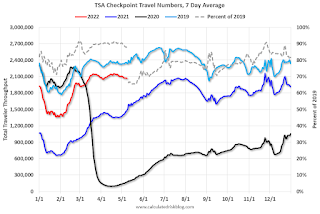 Click on graph for larger image.
Click on graph for larger image.This data shows the 7-day average of daily total traveler throughput from the TSA for 2019 (Light Blue), 2020 (Black), 2021 (Blue) and 2022 (Red).
The dashed line is the percent of 2019 for the seven-day average.
The 7-day average is down 11.7% from the same day in 2019 88.3% of 2019). (Dashed line)
 This data shows domestic box office for each week and the median for the years 2016 through 2019 (dashed light blue).
This data shows domestic box office for each week and the median for the years 2016 through 2019 (dashed light blue). Note that the data is usually noisy week-to-week and depends on when blockbusters are released.
Movie ticket sales were at $87 million last week, down about 70% from the median for the week.
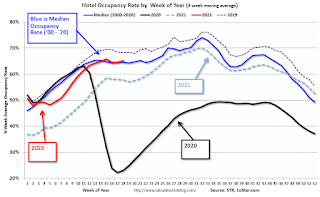 This graph shows the seasonal pattern for the hotel occupancy rate using the four-week average.
This graph shows the seasonal pattern for the hotel occupancy rate using the four-week average. The red line is for 2022, black is 2020, blue is the median, and dashed light blue is for 2021.
This data is through April 30th. The occupancy rate was down 3.4% compared to the same week in 2019.
Notes: Y-axis doesn't start at zero to better show the seasonal change.
Here is some interesting data on New York subway usage (HT BR).
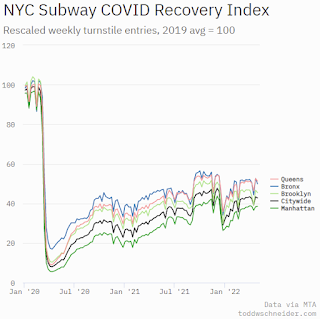 This graph is from Todd W Schneider.
This graph is from Todd W Schneider. This data is through Friday, May 6th.
He notes: "Data updates weekly from the MTA’s public turnstile data, usually on Saturday mornings".
Sunday, May 08, 2022
Sunday Night Futures
by Calculated Risk on 5/08/2022 06:40:00 PM
Weekend:
• Schedule for Week of May 8, 2022
Monday:
• At 2:00 PM ET, Senior Loan Officer Opinion Survey on Bank Lending Practices for April.
From CNBC: Pre-Market Data and Bloomberg futures S&P 500 are down 25 and DOW futures are down 170 (fair value).
Oil prices were up over the last week with WTI futures at $109.60 per barrel and Brent at $112.24 per barrel. A year ago, WTI was at $66 and Brent was at $69 - so WTI oil prices are up 70% year-over-year.
Here is a graph from Gasbuddy.com for nationwide gasoline prices. Nationally prices are at $4.31 per gallon. A year ago prices were at $2.95 per gallon, so gasoline prices are up $1.36 per gallon year-over-year.
Vehicle Sales Mix and Heavy Trucks
by Calculated Risk on 5/08/2022 09:49:00 AM
This graph shows the percent of light vehicle sales between passenger cars and trucks / SUVs through April 2022.
 Over time the mix has changed more and more towards light trucks and SUVs.
Over time the mix has changed more and more towards light trucks and SUVs.Only when oil prices are high, does the trend slow or reverse.
The percent of light trucks and SUVs was at 79.0% in April 2022 - just below the record high percentage of 80.0% last October.
The second graph shows heavy truck sales since 1967 using data from the BEA. The dashed line is the April 2022 seasonally adjusted annual sales rate (SAAR).
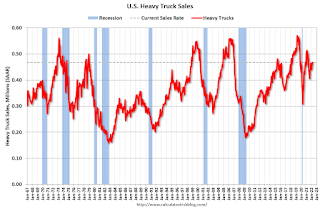 Heavy truck sales really collapsed during the great recession, falling to a low of 180 thousand SAAR in May 2009. Then heavy truck sales increased to a new all-time high of 563 thousand SAAR in September 2019.
Heavy truck sales really collapsed during the great recession, falling to a low of 180 thousand SAAR in May 2009. Then heavy truck sales increased to a new all-time high of 563 thousand SAAR in September 2019.Note: "Heavy trucks - trucks more than 14,000 pounds gross vehicle weight."
Heavy truck sales really declined at the beginning of the pandemic, falling to a low of 299 thousand SAAR in May 2020.
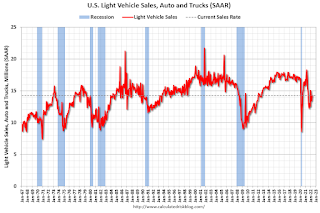 The last graph shows light vehicle sales since the BEA started keeping data in 1967. The BEA reported sales of 14.29 million SAAR in April 2022 (Seasonally Adjusted Annual Rate), up 6.6% from the March sales rate, and down 21.9% from April 2021.
The last graph shows light vehicle sales since the BEA started keeping data in 1967. The BEA reported sales of 14.29 million SAAR in April 2022 (Seasonally Adjusted Annual Rate), up 6.6% from the March sales rate, and down 21.9% from April 2021.The impact of COVID-19 was significant, and April 2020 was the worst month. After April 2020, sales increased, and were close to sales in 2019 (the year before the pandemic).
Saturday, May 07, 2022
Real Estate Newsletter Articles this Week
by Calculated Risk on 5/07/2022 02:11:00 PM
At the Calculated Risk Real Estate Newsletter this week:
• Housing: "What Killed the Home ATM in 2006?"
• Black Knight Mortgage Monitor: Record Low Delinquencies, "Home Affordability Nears All-Time Low"
• Rent Increases Up Sharply Year-over-year, Pace may be slowing
• Denver Real Estate in April: Active Inventory up Sharply
• Lawler: Mortgage/Treasury Spreads, Part I
• 1st Look at Local Housing Markets in April Realtor.com shows active inventory down only 3% year-over-year
This is usually published 4 to 6 times a week and provides more in-depth analysis of the housing market.
The blog will continue as always!
You can subscribe at https://calculatedrisk.substack.com/
Schedule for Week of May 8, 2022
by Calculated Risk on 5/07/2022 08:11:00 AM
The key report this week is April CPI.
Note: The Census Bureau is expected to release "National, State, and County housing units" from the 2020 Census sometime in May.
2:00 PM: Senior Loan Officer Opinion Survey on Bank Lending Practices for April.
6:00 AM ET: NFIB Small Business Optimism Index for April.
11:00 AM: NY Fed: Q1 Quarterly Report on Household Debt and Credit
7:00 AM ET: The Mortgage Bankers Association (MBA) will release the results for the mortgage purchase applications index.
8:30 AM: The Consumer Price Index for April from the BLS. The consensus is for 0.2% increase in CPI (up 8.1% YoY), and a 0.4% increase in core CPI (up 6.1% YoY).
8:30 AM: The initial weekly unemployment claims report will be released. The consensus is for 210 thousand up from 200 thousand last week.
8:30 AM: The Producer Price Index for April from the BLS. The consensus is for a 0.5% increase in PPI, and a 0.6% increase in core PPI.
10:00 AM: University of Michigan's Consumer sentiment index (Preliminary for May).
10:00 AM: NY Fed: Climate Change: Implications for Macroeconomics
Friday, May 06, 2022
COVID May 6, 2022: New Cases, Hospitalizations and Deaths Increasing
by Calculated Risk on 5/06/2022 09:21:00 PM
On COVID (focus on hospitalizations and deaths):
| COVID Metrics | ||||
|---|---|---|---|---|
| Now | Week Ago | Goal | ||
| Percent fully Vaccinated | 66.3% | --- | ≥70.0%1 | |
| Fully Vaccinated (millions) | 220.0 | --- | ≥2321 | |
| New Cases per Day3🚩 | 67,263 | 54,883 | ≤5,0002 | |
| Hospitalized3🚩 | 12,602 | 11,162 | ≤3,0002 | |
| Deaths per Day3🚩 | 341 | 315 | ≤502 | |
| 1 Minimum to achieve "herd immunity" (estimated between 70% and 85%). 2my goals to stop daily posts, 37-day average for Cases, Currently Hospitalized, and Deaths 🚩 Increasing 7-day average week-over-week for Cases, Hospitalized, and Deaths ✅ Goal met. | ||||
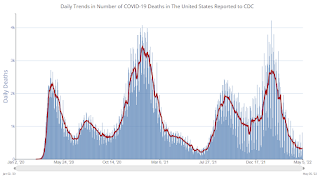 Click on graph for larger image.
Click on graph for larger image.This graph shows the daily (columns) and 7-day average (line) of deaths reported.
Average daily deaths bottomed in July 2021 at 214 per day.
AAR: April Rail Carloads and Intermodal Down Year-over-year
by Calculated Risk on 5/06/2022 03:46:00 PM
From the Association of American Railroads (AAR) Rail Time Indicators. Graphs and excerpts reprinted with permission.
U.S. rail traffic in April 2022 was like a box of assorted chocolates: it had something for everyone. Optimists can point to several commodities that had solid traffic gains. For example, April 2022 was the third best month ever for carloads of chemicals, with carloads up 3.4% over last year. April’s carloads of iron and steel scrap were the highest since August 2013, while carloads of autos and auto parts were up 12.0% over last year. Carloads of food products and crushed stone and sand were also up.
Pessimists can point to several traffic categories with lower volumes in April. For example, carloads of grain in April were the fewest in seven months, coal carloads were the lowest in more than a year, and carloads of petroleum products were their second lowest since September 2017.
emphasis added
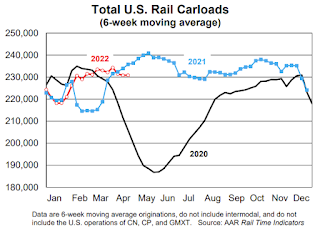 Click on graph for larger image.
Click on graph for larger image.This graph from the Rail Time Indicators report shows the six-week average of U.S. Carloads in 2020, 2021 and 2022:
Total carloads on U.S. railroads fell 3.4% in April 2022 from April 2021, their second monthly decline so far this year following 10 straight monthly gains from March to December 2021. For 2022 through April, total carloads were up 1.1% over the same period in 2021.
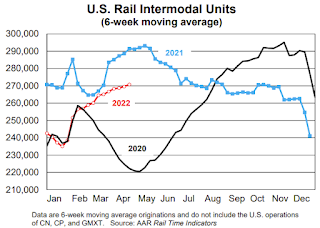 The second graph shows the six-week average (not monthly) of U.S. intermodal in 2020, 2021 and 2022: (using intermodal or shipping containers):
The second graph shows the six-week average (not monthly) of U.S. intermodal in 2020, 2021 and 2022: (using intermodal or shipping containers):U.S. railroads originated an average of 270,788 intermodal containers and trailers per week in April 2022. That’s the most since August 2021, but down 7.7% from April 2021. For context, April 2021 was the best intermodal month in history for U.S. railroads.
1st Look at Local Housing Markets in April; Realtor.com shows active inventory down only 3% year-over-year
by Calculated Risk on 5/06/2022 11:31:00 AM
Today, in the Calculated Risk Real Estate Newsletter: 1st Look at Local Housing Markets in April
A brief excerpt:
Here is a summary of active listings for these housing markets in April. Note: Inventory usually increases seasonally in April, so some month-over-month (MoM) increase is not surprising.There is much more in the article. You can subscribe at https://calculatedrisk.substack.com/
Inventory was up 31.7% in April MoM from March, and up 9.7% year-over-year (YoY). The YoY increase in inventory in these markets was impacted by San Diego (a very tight market). The other markets were up YoY.
These markets were down 26% YoY in February, and unchanged YoY in March, so this is a significant change from February and March. This is another step towards a more balanced market, but inventory levels are still very low.
Notes for all tables:
1) New additions to table in BOLD.
2) Northwest (Seattle)
Used Vehicle Wholesale Prices Decline Seasonally Adjusted in April
by Calculated Risk on 5/06/2022 11:05:00 AM
From Manheim Consulting today: Wholesale Used-Vehicle Prices Decline in April From Seasonal Adjustment
Wholesale used-vehicle prices (on a mix-, mileage- and seasonally adjusted basis) declined 1.0% in April from March. The Manheim Used Vehicle Value Index declined to 221.2, which was up 14.0% from a year ago. The non-adjusted price change in April was an increase of 2.9% compared to March, leaving the unadjusted average price up 16.4% year over year.
Manheim Market Report (MMR) values saw weekly price increases that were strongest to start April and slowed as the month progressed.
emphasis added
 Click on graph for larger image.
Click on graph for larger image.This index from Manheim Consulting is based on all completed sales transactions at Manheim’s U.S. auctions.
Comments on April Employment Report
by Calculated Risk on 5/06/2022 09:11:00 AM
This was another solid report.
The headline jobs number in the April employment report was slightly above expectations, however employment for the previous two months was revised down by 39,000. The participation rate and the employment-population ratio both decreased slightly, and the unemployment rate was unchanged at 3.6%.
In April, the year-over-year employment change was 6.6 million jobs.
Permanent Job Losers
 Click on graph for larger image.
Click on graph for larger image.This graph shows permanent job losers as a percent of the pre-recession peak in employment through the report today.
In April, the number of permanent job losers decreased to 1.386 million from 1.392 million in the previous month.
Prime (25 to 54 Years Old) Participation
 Since the overall participation rate has declined due to cyclical (recession) and demographic (aging population, younger people staying in school) reasons, here is the employment-population ratio for the key working age group: 25 to 54 years old.
Since the overall participation rate has declined due to cyclical (recession) and demographic (aging population, younger people staying in school) reasons, here is the employment-population ratio for the key working age group: 25 to 54 years old.The 25 to 54 participation rate decreased in April to 82.4% from 82.5% in March, and the 25 to 54 employment population ratio decreased to 79.9% from 80.0% the previous month.
Part Time for Economic Reasons
 From the BLS report:
From the BLS report:"The number of persons employed part time for economic reasons was little changed at 4.0 million in April and is down by 357,000 from its February 2020 level. These individuals, who would have preferred full-time employment, were working part time because their hours had been reduced or they were unable to find full-time jobs."The number of persons working part time for economic reasons decreased in April to 4.033 million from 4.170 million in March. This is below pre-recession levels.
These workers are included in the alternate measure of labor underutilization (U-6) that increased to 7.0% from 6.9% in the previous month. This is down from the record high in April 22.9% for this measure since 1994. This measure at the 7.0% in February 2020 (pre-pandemic).
Unemployed over 26 Weeks
 This graph shows the number of workers unemployed for 27 weeks or more.
This graph shows the number of workers unemployed for 27 weeks or more. According to the BLS, there are 1.483 million workers who have been unemployed for more than 26 weeks and still want a job, up from 1.428 million the previous month.
This does not include all the people that left the labor force.
Summary:
The headline monthly jobs number was slightly above expectations; however, the previous two months were revised down by 39,000 combined.


